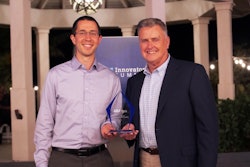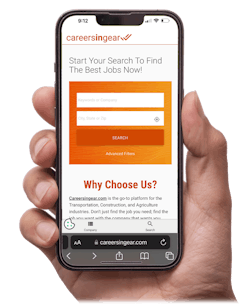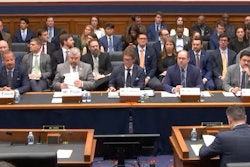Hours of service. Location. Weather. Traffic. Speed. Driver on-time appointments. Driver home time. All are data points that GP Transco uses to simulate estimated times of arrival (ETA) and estimated times en (ETE) route to determine the best driver for the best load to make the best financial decision for the company.
The Illinois dry-van carrier with 520 tractors, 500 company drivers and 20 owner operators, was previously recognized as a CCJ Innovator in 2022 for its SaaS-based OpenRoad TMS, which it designed to meet the company’s specific needs.
In the same way the carrier was unable to find a TMS on the market to fit its needs, it couldn’t find the tools on the market it has since developed, expanding upon the OpenRoad TMS innovation.
The carrier is now pulling data from its in-house developed TMS and applying artificial intelligence to optimize planning and minimize wait times with its HOS ETA/ETE Simulator and save time for capacity planners, eliminate human errors and optimize driver-load matching at scale with its Loads and Drivers Recommender.
Together, the two new AI-powered tools have improved driver and customer satisfaction because of less down time and more on-time deliveries, respectively, said Amos Savickas, executive vice president of operations at GP Transco. The tools have also optimized driver and load planning and even increased rate per hour.
“The biggest impact right now we're seeing is that my planning team has more time on their hands. That’s because most of the loads right now – at least for the day of – are being pre planned pretty well by the tool, so they don't really have to make any decisions anymore,” Savickas said. “If a planner isn’t as efficient in their planning and maybe assigns a shipment that could have been assigned to a different driver that would have made a little bit more financial sense, if they make that slight mistake, the rate per hour then drops down because there's time wasted in between the shipments, or the transit times are too long for that particular driver on that particular shipment. So we're seeing the rate per hour has been increasing slightly since we started the tool.”
Improving planning
Once OpenRoad TMS was in place, it highlighted other opportunities to improve.
GP Transco CEO Dominic Zastarskis said the carrier was heavy on spot market freight and is now seeking more contract freight. In doing so, the company has gained many new customers. He said with fewer customers, these tools would be overkill, but with 25 to 50 new customers with lots of unknowns, this tool becomes really effective.
“The operational problem that we had was the fact that when we have multiple loads and multiple drivers, we need to understand the next load: when it's picking up, whether it's going to be on time or not,” Zastarskis said. “The hours of service is dynamic. It's constantly changing. So we needed an AI to simulate which driver on which load will be on time (and most profitable).”
Savickas said capacity planners were previously planning loads manually, which meant human error. They were giving loads to drivers that made no sense based on the data, and seeing that on a daily basis prompted GP Transco to seek another in-house solution.
“With software, those mistakes can't happen because it's based on numbers; it’s a math problem,” he said.
But these tools are still developing, he added, because with AI, the more information it is fed, the better it gets. So, if the load planner, who is monitoring the recommendations made by the AI, sees that the tool could have made a better decision, that feedback is immediately provided to IT so the team can tweak the system to lessen the likelihood for mistakes.
The tools
These tools were added into OpenRoad TMS in early Q4 last year.
The HOS ETA/ETE Simulator is an AI-powered tool that simulates drivers' estimated time of arrival and estimated time en route for both assigned and future loads in an unlimited sequence. This tool pulls HOS, location, weather, traffic and speed data from the TMS and then, using AI, determines ETA and ETE.
With that data, the Loads and Drivers Recommender then uses AI to pair drivers with loads to minimize costs and maximize fleet-wide profitability by adding in load information, including mileage, toll information and financial/profitability information. It also factors driver-specific information like home time and performance metrics, including a driver’s on-time deliveries in a specified time frame: maybe the last month or the last quarter, for example.
“For the first one (simulator), you could add multiple loads in the mix for a specific driver that you're trying to understand what makes more sense, and it will calculate … which stop will be on time or stop will be too early,” Savickas said. “That goes into the second part (recommender), where now it tells you the most profitable driver to run these three or four loads back-to-back … It's predicting the next best-case scenario for this driver is this load, and then the next one is that load.”
As soon as new data comes into the TMS, the tool recalibrates plans accordingly based on the many variables, and there is no downtime. As loads come into the system, through API or EDI, the software plans a driver’s day, whether it’s a weekend or outside of business hours on a weekday.
Savickas said that means scalability.
“We can easily take on, say, tomorrow, 100 extra drivers, and we could do it with the same staff,” he said. “Imagine if we had to go back to Excel spreadsheets and whiteboards to manage this like back in the day. That would be a disaster for us.
“I'm sure there are companies out here running everything on hard paper, and they're still probably doing okay, but in the long term and in terms of scalability growth, I think you have to jump on that wagon and count on technology because you're going to get left behind” he added.
Zastarskis said the technology enables on-time delivery, which improves customer relations, and also helps the carrier impress prospective customers.
Sergey Bort, GP Transco vice president of marketing and communication, said the company relies on technology so much at this point because it’s like another employee that does a bunch of work.
“We're increasing accuracy and efficiency, and at the same time, we're utilizing fewer humans,” he said. “Those humans can then be doing other work that AI maybe would not be helpful with. But as a result, things are a lot more productive in the bigger grand scheme of things.”
Other AI uses
GP Transco is using AI in other areas of its business to drive efficiency.
The company also developed Bids Recommender, a tool designed to suggest the best bids based on its historical bidding data and current lanes. AI is also used in its automated weather alert system that monitors driver positions and sends automatic alerts to the cab if a driver is in or approaches a hazardous area. And another driver element it uses AI for is analyzing driver feedback to gain greater insight into their concerns and challenges to improve retention.
All the load information the company uses for the recommender tool comes in via data entry robot, which combined with EDI automates 95% of load entries, eliminating manual work, said GP Transco’s vice president of engineering Dalia Svirmickiene. She added that normal exceptions are handled manually.
“You still need humans to manage the exceptions for a lot of things,” Savickas said. “It's not like you can do away without anyone monitoring and let the system handle all of it. That's probably never going to happen, just like in the aviation industry. Planes can fly themselves now, but that doesn't mean that you want to be flying in the aircraft without any pilot monitoring it.”
The CCJ Innovators program is sponsored by Comdata, ExxonMobil, Fleetworthy and Mack Trucks.












